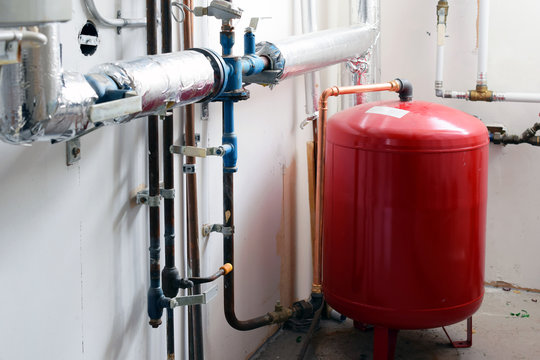
If you have a water heater, furnace, or hydronic system, you may have wondered, “What does an expansion tank do?”
Many homeowners overlook this small but essential component in plumbing systems. An expansion tank manages thermal expansion, protects your water heater, and helps your closed system operate safely.
In this guide, we will explain tank expansion, heater expansion, how pressure is regulated, and why proper installation, maintenance, and repair are important for your home plumbing.
Understanding Thermal Expansion and Tank Expansion
When water is heated in a water heater, it expands. This is called thermal expansion.
In a closed system, this expanding water has nowhere to go, which can cause increased pressure that may damage the water heater, pipes, or fixtures.
An expansion tank acts as a buffer. It absorbs the extra water from heater expansion, keeping system pressure within safe limits. These tanks can be installed vertically or horizontally depending on the piping layout and hydronic system setup.
Choosing the right tank ensures efficient operation and prevents unnecessary strain on plumbing systems.
How Expansion Tanks Work
Expansion tanks usually consist of two compartments separated by a rubber diaphragm. One side contains air, and the other connects to the water system. When water in the heater expands, the extra volume enters the tank, compressing the air and reducing pressure fluctuations in the system.
The main benefits of an expansion tank include:
- Reducing pressure changes to maintain consistent pressure in plumbing systems.
- Protecting water heaters and piping from damage caused by excessive pressure.
- Extending the life of valves, faucets, and fixtures by reducing stress caused by thermal expansion.
Proper sizing is important. A tank that is too small will not absorb enough water, while a tank that is too large is unnecessary. Professionals can determine the correct tank expansion based on water heater size, system pressure, and daily water usage.
Types of Expansion Tanks
Not all expansion tanks are the same. Understanding the different types helps in selecting the best one for your system.
- Compression tanks use an air cushion to absorb expanding water and are common in older steam or hydronic systems.
- Diaphragm or bladder tanks have a rubber diaphragm separating air and water. They are ideal for modern water heaters and closed hydronic systems because they offer better efficiency and durability.
Each type controls thermal expansion, reduces pressure, and protects the plumbing system. In heating and plumbing systems, diaphragm tanks are usually preferred because they provide long-term service life.
Signs You Need Expansion Tank Maintenance or Repair
Even a well-designed expansion tank requires maintenance. Look for these signs that your tank may need repair or inspection:
- Frequent pressure fluctuations in the water heater or furnace.
- Strange noises in piping, hydronic systems, or heating systems.
- Visible water leaks around the tank or valves.
- Tripping of pressure relief valves on the water heater.
Regular maintenance, including checking the air pressure and inspecting the diaphragm, can prevent failures. Professional services can perform inspections and ensure the tank is functioning properly.
Proper Installation and Placement
Correct installation is critical for an expansion tank’s performance.
Professional plumbers consider several factors:
Location: The tank should connect directly to the cold water line of the water heater or hydronic system.
Orientation: Tanks can be installed horizontally or vertically depending on piping and space.
Pressure settings: The air charge in the tank must match the system pressure to control thermal expansion effectively.
Accessibility: The tank should be easy to reach for future maintenance or repair.
Professional installation ensures the expansion tank is set up correctly, protecting the system and providing long-term reliability.
Integration with Hydronic and Heating Systems
Expansion tanks are not just for water heaters. In closed hydronic and heating systems, they prevent pressure surges that could damage pumps, piping, and furnaces. In steam systems, tank expansion helps reduce stress and prevent leaks.
Key points for heating systems include:
- In hydronic systems, the tank compensates for water expansion caused by heat.
- For furnaces, expansion tanks reduce strain on pumps and heating loops.
- Modern plumbing and heating systems often combine water heaters with expansion tanks to ensure both hot water and heating loops stay safe.
Professional installation and regular service ensure hydronic systems operate efficiently and reduce the need for repairs.
Professional plumbing services from Trusted Plumbing.
FAQs
What does an expansion tank do?
It absorbs extra water caused by heater expansion, controlling pressure and protecting plumbing systems.
How often should it be serviced?
Annually or whenever there are pressure spikes, leaks, or unusual noises.
Can it fail?
Yes. Diaphragms can wear out, air pressure can drop, or leaks may occur. Regular maintenance prevents these problems.
Do all water heaters need one?
Modern closed system water heaters usually require an expansion tank, and some plumbing codes mandate it.
Understanding what an expansion tank does is essential for homeowners with water heaters, hydronic systems, or furnaces. By managing thermal expansion, controlling pressure, and protecting plumbing systems, expansion tanks prevent damage and prolong the life of water heaters and heating systems.
Regular maintenance, repair, and professional installation are key to keeping the tank effective. Expert services can ensure the expansion tank is properly sized, installed, and maintained, providing reliable performance for water heaters, heating systems, and home plumbing.

